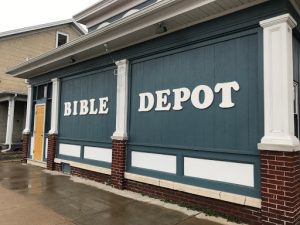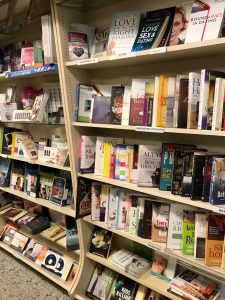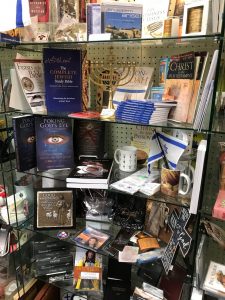A Bull in a China Shop
Imagine walking into a store and every step you take, you become more than just a customer, you become a bull in a china shop. Now, in this case, being a bull isn’t a negative thing because in the end, all it means is that there is a wide variety of books and products to browse. Bible Depot is known for its unique building structure from the inside and out. Originally built in the 1930s, this structure was first designed as a house, which is still lived in today. This not only gives the business a personal touch, but highly affects the floor plan due to the already established layout. The only way to fully understand this paperback and knick knack forest is to experience for yourself. There’s no surprise that when you enter Bible Depot, you will get “lost” in the books.

Entering the Maze
Throughout time, Bible Depot has evolved their store, making it more distinct every day. When the business first landed on Front Street in 1940, the entrance was formerly on the street side, facing the river. After a couple years, the business decided to make the front door the mail drop-off, moving the official entrance  to the side door. When you first step into Bible Depot, you immediately encounter merchandise. You are face to face with children’s toys and smaller knick knacks. Everything ranging from bible erasers to science kits, there is an abundance of different products. You would then follow the path to begin browsing, but due to fact this was not built for a store, Bible Depot does not have an official walkthrough pattern. In that moment, I decided to take a chance and choose the most “efficient” pattern and continue right. The front room, lined with bookshelves, surrounds the center display case with shelfs on both sides. Working through the first “isle”, the wall to your right is filled with Easter books, décor, historical biographies and a variety of religious movies. One of the most interesting sections in that isle is the Jewish category directly across the Easter products in the display case. Seeing how the store is majority for Christians, Nancy wanted to add in a part of her Jewish background and invite other religions to come in and feel welcomed. Before turning left and making your way into the second room, there are prayer books and general novels that cover an entire wall. Once you enter the “baby room”, you notice it is roughly the size of a single bathroom and holds a small selection of baby clothes, rattles, etc. An interesting part to this room is the window which reveals the kitchen of Nancy’s home. Throughout the store, there are doors and windows which lead into her house. Since there are no doors on the hinges, it creates a “open floorplan” which allows you to walk room to room. The next room is similar to the front room where the walls are lined in bookshelves full of communion gifts and more novels. In the center of the room, a variety of cards are displayed creating another circle walking pattern. Walking out of this room, you continue through the baby room and make your way back to the front of the store, where you can find marriage books, health remedies, family-oriented gifts and much more.
to the side door. When you first step into Bible Depot, you immediately encounter merchandise. You are face to face with children’s toys and smaller knick knacks. Everything ranging from bible erasers to science kits, there is an abundance of different products. You would then follow the path to begin browsing, but due to fact this was not built for a store, Bible Depot does not have an official walkthrough pattern. In that moment, I decided to take a chance and choose the most “efficient” pattern and continue right. The front room, lined with bookshelves, surrounds the center display case with shelfs on both sides. Working through the first “isle”, the wall to your right is filled with Easter books, décor, historical biographies and a variety of religious movies. One of the most interesting sections in that isle is the Jewish category directly across the Easter products in the display case. Seeing how the store is majority for Christians, Nancy wanted to add in a part of her Jewish background and invite other religions to come in and feel welcomed. Before turning left and making your way into the second room, there are prayer books and general novels that cover an entire wall. Once you enter the “baby room”, you notice it is roughly the size of a single bathroom and holds a small selection of baby clothes, rattles, etc. An interesting part to this room is the window which reveals the kitchen of Nancy’s home. Throughout the store, there are doors and windows which lead into her house. Since there are no doors on the hinges, it creates a “open floorplan” which allows you to walk room to room. The next room is similar to the front room where the walls are lined in bookshelves full of communion gifts and more novels. In the center of the room, a variety of cards are displayed creating another circle walking pattern. Walking out of this room, you continue through the baby room and make your way back to the front of the store, where you can find marriage books, health remedies, family-oriented gifts and much more.
 With half of the store complete, we lead into the “jewelry room” but quickly turn right into another room. I found it helpful to stay to the right throughout the whole store because it anchored my focus and I was able to track my path. Because Bible Depot has a huge variety of books and merchandise, it was hard choosing my favorite selection, but was nice being able to get “lost” in the writings. Walking into the bible room, it was so quiet I could easily pick up a book and begin reading it without distraction. In this situation, we ponder on Laura J. Miller’s discussion in ‘Reluctant Capitalists’ on whether consumers want a bookstore owner to be a sales clerk or simply engage in conversation (62). I believe it’s comforting to have advice and conversations, but think time to yourself is a respectful factor in a bookstore. The final room we land in before making our way back into the “jewelry room” was considered the “entertainment” section due to the number of hymns, CDs and movies. With all of these items spread throughout the room, it ranged from Jewish sheet music to contemporary Christian music which shows how diverse Bible Depot is. Making our way out of the maze and ending in the jewelry room, the check out counter is in the back corner with the store’s office directly behind.
With half of the store complete, we lead into the “jewelry room” but quickly turn right into another room. I found it helpful to stay to the right throughout the whole store because it anchored my focus and I was able to track my path. Because Bible Depot has a huge variety of books and merchandise, it was hard choosing my favorite selection, but was nice being able to get “lost” in the writings. Walking into the bible room, it was so quiet I could easily pick up a book and begin reading it without distraction. In this situation, we ponder on Laura J. Miller’s discussion in ‘Reluctant Capitalists’ on whether consumers want a bookstore owner to be a sales clerk or simply engage in conversation (62). I believe it’s comforting to have advice and conversations, but think time to yourself is a respectful factor in a bookstore. The final room we land in before making our way back into the “jewelry room” was considered the “entertainment” section due to the number of hymns, CDs and movies. With all of these items spread throughout the room, it ranged from Jewish sheet music to contemporary Christian music which shows how diverse Bible Depot is. Making our way out of the maze and ending in the jewelry room, the check out counter is in the back corner with the store’s office directly behind.
More Than Just an Object
Though the store is categorized in interests and group s, Nancy Ney, the owner, described her store as “crunchy”. She specified that when they began their inventory, there was no method to the layout. Nancy wanted to fit as much as possible in each room to give her customers everything at their fingertips. Bible Depot cares less about the corporate and professional image and more about creating a personal connection to each and every customer. Having one of the biggest religious supplies inventory in town, Bible Depot has grown their collection for a wider demographic, not just for a specific group. When exploring this store from an outsider’s perspective, these objects may not have had an impact to me but to others, they could mean the world. As acknowledged in ‘Reluctant Capitalists’, “the tendency to view books as a special kind of object is perhaps best seen in the reluctance to call books “products” at all (Miller 219). Yes, Bible Depot sells children’s toys and small music boxes, but the spiritual connection between these items and the religious community is what keeps customers coming back.
s, Nancy Ney, the owner, described her store as “crunchy”. She specified that when they began their inventory, there was no method to the layout. Nancy wanted to fit as much as possible in each room to give her customers everything at their fingertips. Bible Depot cares less about the corporate and professional image and more about creating a personal connection to each and every customer. Having one of the biggest religious supplies inventory in town, Bible Depot has grown their collection for a wider demographic, not just for a specific group. When exploring this store from an outsider’s perspective, these objects may not have had an impact to me but to others, they could mean the world. As acknowledged in ‘Reluctant Capitalists’, “the tendency to view books as a special kind of object is perhaps best seen in the reluctance to call books “products” at all (Miller 219). Yes, Bible Depot sells children’s toys and small music boxes, but the spiritual connection between these items and the religious community is what keeps customers coming back.
Being a place of religion, these items are not just decorations or books, they symbolize someone’s faith, beliefs and life. Like most books, people tend to connect to the ones which most define them. Whether it’s comics, health, religious, etc., we collect and appreciate objects that make each and every one of us unique. After emerging myself into Bible Depot and wandering from room to room, I began to respect the amount of love and community that shares this sacred location. Though I am not religious, as you browse each section, you are able to understand that it doesn’t matter about how precise a shelf is stacked or the layout of the store. As Nancy said, “It’s crunchy. I think it gives it character”. Bible Depot’s floor plan is not perfect, but as long as you admire the objects within, you will experience exactly what the bookstore has to offer.
Sources
Photos:
- Provided by John Bucci
- Provided by Anna Chobanoff
Book:
- Miller, Laura J. Reluctant Capitalists: Bookselling and the Culture of Consumption. Chicago: University of Chicago Press, 2006.

0 Comments